Review: Niner's 2019 RIP 9 RDO 29
The RIP 9 RDO is back, and it's a ripper. Niner fans have been waiting for the re-release of the brand's flagship long-travel trail bike since the first name in 29ers was sold to United Wheels in March 2018. Much was at stake. It's no secret that Niner's following has traditionally come from cross country roots but, like the sport at large, many of them were evolving towards more aggressive skill sets.
The RIP 9 RDO was launched back in 2015. It was Niner's first crack at addressing the all-mountain crowd with an aggressive-for-the-time, long-travel chassis. The RDO was well received, and its appearance coincided with the explosive growth of enduro. Timing, however, couldn't have been worse for Niner. They were riding on the RIP 9 RDO's momentum, with a new all-mountain design ready for production, but lacked the cash to launch it successfully.
The RIP 9 RDO was launched back in 2015. It was Niner's first crack at addressing the all-mountain crowd with an aggressive-for-the-time, long-travel chassis. The RDO was well received, and its appearance coincided with the explosive growth of enduro. Timing, however, couldn't have been worse for Niner. They were riding on the RIP 9 RDO's momentum, with a new all-mountain design ready for production, but lacked the cash to launch it successfully.
RIP 9 RDO 29 Details
• Intended use: Trail/All-mountain
• Travel: 140mm rear / 150mm front
• Wheel size: 29" (tested) and 27.5" models available
• Construction: Carbon fiber, CVA dual-link suspension
• Flip Chip toggles geometry +/- 1°
• Head angle: 66°/65°
• Chainstay length: 435mm/437mm
• Reach: (M) 440mm/430mm
• Sizes: S, M, L, XL
• Weight: (Size M 29") 30.5 lbs (13.76 kg)
• Price: $8800 to $4500 USD ($6950 4-Star Eagle X01 build tested)
• More info: Niner Bikes
• Intended use: Trail/All-mountain
• Travel: 140mm rear / 150mm front
• Wheel size: 29" (tested) and 27.5" models available
• Construction: Carbon fiber, CVA dual-link suspension
• Flip Chip toggles geometry +/- 1°
• Head angle: 66°/65°
• Chainstay length: 435mm/437mm
• Reach: (M) 440mm/430mm
• Sizes: S, M, L, XL
• Weight: (Size M 29") 30.5 lbs (13.76 kg)
• Price: $8800 to $4500 USD ($6950 4-Star Eagle X01 build tested)
• More info: Niner Bikes
Meet the New RIP RDO 29
Two big disclosures: Niner broke tradition and made one RIP 9 RDO model dedicated to 29-inch wheels, and a separate design for 27.5-inch wheels. That's crazy stuff! You'd think then, based upon the novelty alone, that PB would ask for the smaller wheels. But... we chose the 29er instead.
Twenty nine inch wheels are enjoying a renaissance now that folks have finally figured out the right mix of offset, angles and frame number to incorporate long travel suspension. Niner has been doing big wheels longer than almost every brand out there and, if you've watched any Kirt Voreis videos lately, you'd probably want to experience their take on the ultimate all-mountain 29er. I did.
Twenty nine inch wheels are enjoying a renaissance now that folks have finally figured out the right mix of offset, angles and frame number to incorporate long travel suspension. Niner has been doing big wheels longer than almost every brand out there and, if you've watched any Kirt Voreis videos lately, you'd probably want to experience their take on the ultimate all-mountain 29er. I did.
What about that carbon chassis? Two ribs surround the Fox DPX2 shock - the frame's standout design element, used to directly reinforce the bottom bracket area against lateral forces. In fact, almost all of the improvements that Niner built into the new RIP RDO chassis were targeted to improve lateral rigidity, while maintaining a little flex in the linear plane to mute G-outs and larger impact events. More on that later.
Look beyond its steep seat-tube angle, extended reach, and slack front end, and you'll notice an equally worthy component pick. In Niner fashion, four builds are available, ours being the second tier, four-star kit that features a SRAM Eagle XO1 transmission including the carbon crankset. Wheels roll on Stan's NoTubes Flow S1 rims and a capable Maxxis 2.5 WT Aggressor rear/ DHF front tire combination, and it has a Race Face cockpit. Suspension is all Fox, with a 150mm 36 FIT4 fork and DPX2 shock that cranks out 140 millimeters of travel from its CVA rear suspension. The four-star build leaves nothing to want for with an MSRP of $6950 USD.
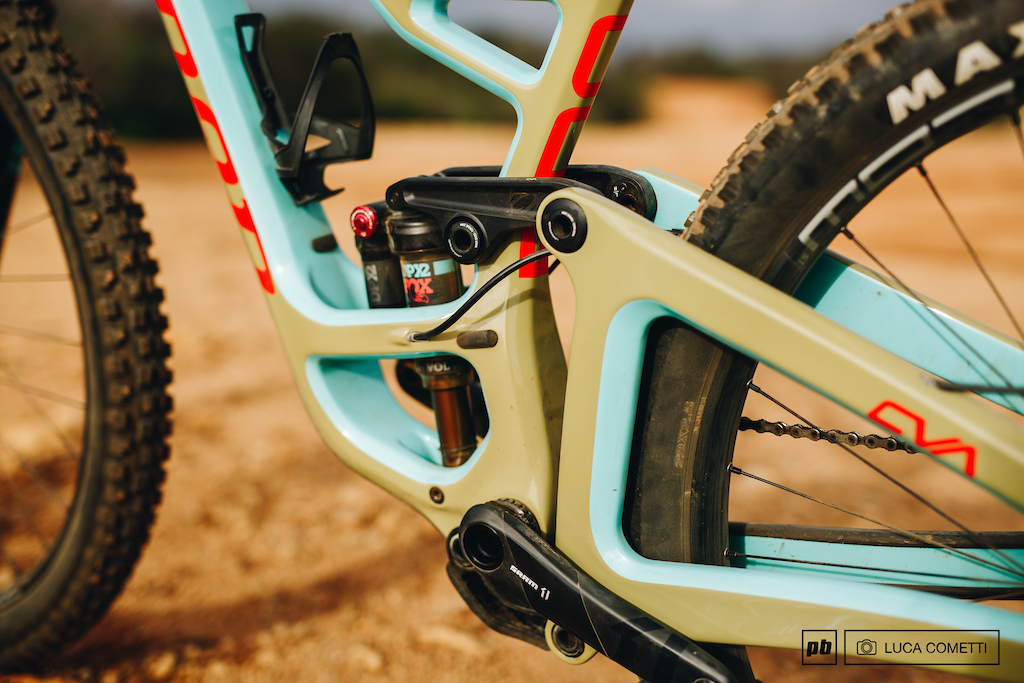
Niner incorporated "ribs" to directly reinforce the seat tube near the upper suspension pivot against lateral flex.
Construction and Features
Niner began life selling frames only, so they pay attention to features that help customers with future upgrades. The RIP 9 RDO has a threaded bottom bracket shell, and full-length tubes to guide cable housing and hoses through the carbon frame. Future proofing comes from things like wiring ports for Fox Live Valve. There's a water bottle mount on the down tube, and Niner put a lot of planning into lowering the seat tube and providing enough straight section to allow owners to run full length droppers. Most will be able to use a 170mm model.
By far, the most visible design elements are the twin "ribs" that encircle the Fox DPX2 damper. Parry says that they wanted to eliminate the seat stay bridge in order to make more room for big tires (the RIP 9 RDO sports Maxxis 2.5 inch WT rubber). To accomplish this, the seat and chainstay tubes are enlarged to provide stiffness and the upper link has been reinforced. That puts an additional load on the seat tube, however, which normally would be countered by enlarging the lower seat tube and bottom bracket area. Parry says, "it's always better to support loads as directly as possible. We did that, using those rib structures to tie in the down tube to the middle of the seat tube and it made a significant improvement - more than we could have accomplished by strengthening the bottom bracket area."
Niner began life selling frames only, so they pay attention to features that help customers with future upgrades. The RIP 9 RDO has a threaded bottom bracket shell, and full-length tubes to guide cable housing and hoses through the carbon frame. Future proofing comes from things like wiring ports for Fox Live Valve. There's a water bottle mount on the down tube, and Niner put a lot of planning into lowering the seat tube and providing enough straight section to allow owners to run full length droppers. Most will be able to use a 170mm model.
Uninitiated viewers often comment about the perceived vulnerability of Niner's lower link, which tucks beneath the bottom bracket shell. It's an element of their CVA suspension, used to provide shorter chainstays and greater tire clearance. Chief designer, George Parry, says that they put a nylon guard on the link to ward off cosmetic damage, but there has never been an issue with that link in the history of Niner's CVA suspension. "It's a sturdy aluminum link," says Parry. "If you do manage to get past the chainring, It'll get dinged up, but it's not going to be affected by rock strikes."
There's a lot going on with the new frame and suspension - visibly and in an engineering sense. Kinematics favor mid-stroke support and the leverage rate was increased to get the shock moving earlier. Visibly, the main frame tubes are wider laterally and thinned on the vertical plane to keep the chassis tracking at speed and in the rough, without creating a bike that rattles the teeth out of its rider over the bumps. Parry says that the built in vertical compliance can be felt.
There's a lot going on with the new frame and suspension - visibly and in an engineering sense. Kinematics favor mid-stroke support and the leverage rate was increased to get the shock moving earlier. Visibly, the main frame tubes are wider laterally and thinned on the vertical plane to keep the chassis tracking at speed and in the rough, without creating a bike that rattles the teeth out of its rider over the bumps. Parry says that the built in vertical compliance can be felt.
By far, the most visible design elements are the twin "ribs" that encircle the Fox DPX2 damper. Parry says that they wanted to eliminate the seat stay bridge in order to make more room for big tires (the RIP 9 RDO sports Maxxis 2.5 inch WT rubber). To accomplish this, the seat and chainstay tubes are enlarged to provide stiffness and the upper link has been reinforced. That puts an additional load on the seat tube, however, which normally would be countered by enlarging the lower seat tube and bottom bracket area. Parry says, "it's always better to support loads as directly as possible. We did that, using those rib structures to tie in the down tube to the middle of the seat tube and it made a significant improvement - more than we could have accomplished by strengthening the bottom bracket area."
Geometry & Sizing
Niner product manager Barrett James was the driving force behind the new RIP 9's geometry. Barrett is one of three accomplished bike handlers on the Niner staff who have been chafing at the bit to get a real gravity bike in the Niner portfolio. Designer George Parry said that he and Barrett thought that the funny thing about the current move towards steep seat angles was that they needed to do that early on to obtain clearance for the rear tire at full compression, and also to bring riders closer to the handlebar because larger wheels required longer reaches to fit everything in place. "That aspect of so called modern geometry kind of fell into our laps," said Parry, "We settled on 75.8 degrees, which is plenty steep to climb well, and it centers the rider over the bike."
Niner offers four sizes and, as mentioned earlier, the head tubes and seat tubes are kept as low as possible to allow "tweener" riders to size up or down to obtain optimal reaches without sacrificing stand-over clearance or dropper-post stroke. That's a good thing, because our medium sized framed bike was more compact than the last two bikes that came through for review. At five foot seven inches (170 cm), most medium sized bikes are roomy for for me. The medium-sized RIP RDO 29, has a 440mm reach with a 40mm stem and it felt just right, so lankier riders may want to size up to a large.
Flip chips are commonplace on today's bikes, but it's a first for Niner. The rocker-mounted chips lower the bottom bracket by seven millimeters and slacken the head tube angle by one degree, from 66 to 65. I may be getting ahead of the story, but I was smacking the cranks about as much as I could tolerate in the high position, so I asked Parry why they bothered with the chip. "We wanted to give gravity riders the option to set the bike up for park and shuttling, where lower is better," says Parry. "But I admit that, in the high position, it's about as low as you'd like to have it for riding both up and down trails. I think we found a good balance with the geometry."
Niner product manager Barrett James was the driving force behind the new RIP 9's geometry. Barrett is one of three accomplished bike handlers on the Niner staff who have been chafing at the bit to get a real gravity bike in the Niner portfolio. Designer George Parry said that he and Barrett thought that the funny thing about the current move towards steep seat angles was that they needed to do that early on to obtain clearance for the rear tire at full compression, and also to bring riders closer to the handlebar because larger wheels required longer reaches to fit everything in place. "That aspect of so called modern geometry kind of fell into our laps," said Parry, "We settled on 75.8 degrees, which is plenty steep to climb well, and it centers the rider over the bike."
Niner offers four sizes and, as mentioned earlier, the head tubes and seat tubes are kept as low as possible to allow "tweener" riders to size up or down to obtain optimal reaches without sacrificing stand-over clearance or dropper-post stroke. That's a good thing, because our medium sized framed bike was more compact than the last two bikes that came through for review. At five foot seven inches (170 cm), most medium sized bikes are roomy for for me. The medium-sized RIP RDO 29, has a 440mm reach with a 40mm stem and it felt just right, so lankier riders may want to size up to a large.
Flip chips are commonplace on today's bikes, but it's a first for Niner. The rocker-mounted chips lower the bottom bracket by seven millimeters and slacken the head tube angle by one degree, from 66 to 65. I may be getting ahead of the story, but I was smacking the cranks about as much as I could tolerate in the high position, so I asked Parry why they bothered with the chip. "We wanted to give gravity riders the option to set the bike up for park and shuttling, where lower is better," says Parry. "But I admit that, in the high position, it's about as low as you'd like to have it for riding both up and down trails. I think we found a good balance with the geometry."
Suspension Design
I expected that Niner would have a story about new kinematics and leverage curves, but Parry said that they have worked out the CVA kinematics over time to achieve the right balance between pedaling and ride quality, so they only needed minor changes for the new bike. That translates to slightly more anti-squat, with less "pedal effect." That's Parry's term for using chain tension to stiffen the suspension - a function many erroneously call anti-squat.
I expected that Niner would have a story about new kinematics and leverage curves, but Parry said that they have worked out the CVA kinematics over time to achieve the right balance between pedaling and ride quality, so they only needed minor changes for the new bike. That translates to slightly more anti-squat, with less "pedal effect." That's Parry's term for using chain tension to stiffen the suspension - a function many erroneously call anti-squat.
The most noticeable aspect of the suspension is an increase in mid-stroke support and that the starting leverage has also been increased to overcome the shock's seal friction and provide more grip. Niner's literature also states that the ending stroke leverage curve falls off slightly to compensate for the natural ramp-up of the Fox DPX2's air spring.
Speaking of air springs, Niner's frame development sort of collided with changes with the Fox DPX2 damper, which created a post-production clearance issue with some shock-pumps and the location of the shock's air valve. The frame rib on the air valve side is a tight fit, so the solution was the "crack pipe" - an angled adapter that comes clipped to the RIP 9 RDO's frame and allows easy access to the filler valve.
Niner chose Fox's 36 Float Factory fork with the FIT4 damper and a 150-millimeter stroke. Paired with the bike's 140-millimeter-travel tail end, that seems to be the sweet spot for all but the most aggressive gravity riders on 29ers these days. I like the 36 because I can set it and forget it, almost from the first ride. The offset is reduced to the now popular 44 millimeters, which works fine for me with a light, but consistent feel at the handlebar.
RIP 9 RDO 29 Four Star Build
| Specifications | ||
| Release Date | 2019 | |
| Price | $6950 | |
| Travel | 140mm | |
| Rear Shock | Fox DPX2 EVOL | |
| Fork | Fox 36 Float Factory FIT4 Kashima 150mm | |
| Headset | Tapered | |
| Cassette | SRAM EAGLE XG | |
| Crankarms | SRAM X1 Eagle Carbon DUB 32T | |
| Chainguide | NA | |
| Bottom Bracket | SRAM DUB threaded | |
| Pedals | NA | |
| Rear Derailleur | SRAM Eagle XO1 | |
| Chain | SRAM Eagle XO1 | |
| Front Derailleur | NA | |
| Shifter Pods | SRAM Eagle XO1 | |
| Handlebar | Race Face Next R 800mm wide, 20mm rise 35mm clamp | |
| Stem | Race Face Turbine R 40m x 35mm clamp | |
| Grips | Niner | |
| Brakes | SRAM Guide Ultimate Carbon 180/180mm Centerline rotors | |
| Wheelset | Custom | |
| Hubs | Neo | |
| Spokes | Butted stainless | |
| Rim | Stan's NoTubes Flow S1 | |
| Tires | Maxxis WT 2.5" Aggressor R, DHF F | |
| Seat | Niner custom | |
| Seatpost | SDG Tellis (S-125mm, M-150mm, L/XL-170mm) | |
Riding in mild winter conditions gave me the chance to scrape up slippery rock gardens, drift around snowy corners and experience some of the best hero dirt we've had in Southern California for a long while. I've had the Niner RIP 9 RDO 29 for a couple of months, and have become quite familiar with it. Initial setup is made easy by Niner's rocker-located suspension sag indicator, which encourages 30-percent on the pip. I found that I needed a slightly softer setup to prevent the shock from overdriving the fork, which I set at 20 percent sag with both compression and rebound at Fox's sticker recommendations.
Later, Niner sent a memo that suggested that I switch the Fox DPX2's .4 air-volume spacer with a more linear .2 sized spacer. That would be the only issue that cropped up with the Niner's suspension through the entire review period. My feelings were echoed by two other riders I regularly share testing duties with who are much harder on the bike than I am.
Later, Niner sent a memo that suggested that I switch the Fox DPX2's .4 air-volume spacer with a more linear .2 sized spacer. That would be the only issue that cropped up with the Niner's suspension through the entire review period. My feelings were echoed by two other riders I regularly share testing duties with who are much harder on the bike than I am.
Niner ships the new RIP 9 with full-width, 800 millimeter bars, so cut them to your satisfaction. I prefer 770mm. Everything in the cockpit felt like a proper pro bike, with one nagging exception that never resolved itself. The SDG Tellis dropper post required a good push to get it to drop. Once in motion, it slid smoothly to position. No, the frame clamp was not too tight, nor was the seal head screwed down excessively. The post was functional throughout the review - just annoying.
The only other tickler was the "crack pipe" adapter, which works great. Remember to keep it handy though. The only time I consciously left it on the workbench was the one time I wished I had it at the trail head.
The only other tickler was the "crack pipe" adapter, which works great. Remember to keep it handy though. The only time I consciously left it on the workbench was the one time I wished I had it at the trail head.
Climbing
No worries in the climbing department. Niner's rear suspension can deliver efficient pedaling with or without the help of the DPX2 shock's low-speed compression lever. When I did employ it, I was ascending fire roads or paved sections to access trails, otherwise, I left it open. The medium-sized frame is roomy enough to pedal comfortably out of the saddle for extended periods, but it never felt stylishly long. I fit it quite well, and as I mentioned earlier in the text, many medium-sized all-mountain bikes are a tad long for me.
If you like a bike that feels super crisp with each pedal stroke, the Niner will fall a little short, but on the dirt - real dirt - its suspension has the right combination of cushion to keep the bike moving forward over the chatter and pedaling firmness to keep your legs feeling fresh.
No worries in the climbing department. Niner's rear suspension can deliver efficient pedaling with or without the help of the DPX2 shock's low-speed compression lever. When I did employ it, I was ascending fire roads or paved sections to access trails, otherwise, I left it open. The medium-sized frame is roomy enough to pedal comfortably out of the saddle for extended periods, but it never felt stylishly long. I fit it quite well, and as I mentioned earlier in the text, many medium-sized all-mountain bikes are a tad long for me.
Traction always seems to be on tap, whether I was scratching my way up a rocky pitch or negotiating tight switchbacks. I rarely had to contort to keep the rear tire biting. I can't recall many times when I had to be concerned about technique in technical climbing situations.
Most of the time, I just powered down, stayed centered over the bike and let the Niner find its way up the rubble. Some of that stability was attributable to the bike's steady steering, which is one of the Niner's strong points.
Most of the time, I just powered down, stayed centered over the bike and let the Niner find its way up the rubble. Some of that stability was attributable to the bike's steady steering, which is one of the Niner's strong points.
If you like a bike that feels super crisp with each pedal stroke, the Niner will fall a little short, but on the dirt - real dirt - its suspension has the right combination of cushion to keep the bike moving forward over the chatter and pedaling firmness to keep your legs feeling fresh.
Descending
This is the first Niner I have ridden that felt comfortable at speed from the outset. It's stable in the corners and its feel at the handlebar is very steady, no wiggling around, just point and go. I like that. Typically, I run my fork about 20 percent stiffer than my shock, and the RIP 9 responds well in that configuration with no front end push and just the right amount of rear wheel drift when I overcook the turns.
Braking leaves a little to be desired. I am surprised that Niner didn't put SRAM Code brakes on this machine, or a 203 millimeter rotor up front. There is plenty of braking power available from the Ultimate brakes and 180 millimeter discs, but you have to ask for it. The Niner's light steering and smooth suspension would be better matched with a brakeset that required a lighter touch. Certainly not a deal breaker, but that's my two cents.
When I did need to brake in earnest, nothing bad happened. There is a lot of grip available from both wheels and the front tire is very predictable on and off the brakes; I can't recall a big push into a turn, ever. That pays big dividends when dropping into rock chutes or muddy descents (a rare pleasure in San Diego). I chalk up much of the bike's control under braking to the fact that I didn't have to shift my weight far to make something happen. It's a very intuitive handing bike.
Suspension performance is assured by Niner's choice of a Fox 36 fork and DPX2 shock. I never switched out the volume spacer in the DPX2 because the CVA suspension delivered such a gentle bottom-out that I could run the shock at 33 percent sag and let it fly. The mid stroke support was still strong enough to keep the bike up in its travel, even though the O-ring was always slammed. I rode some stupid boulders - long sections of them - at a pretty good pace and never got the "bounce of death."
When I handed the bike off to more accomplished riders, I thought the verdict would com back that the RIP 9 was too short and too soft to handle the big stuff. Instead, I got thumbs up and a similar report on the bike's cornering and suspension performance. In short, we all agreed it was an easy bike to ride in just about any situation.
How does it compare?
Let's compare Niner's RIP 9 RDO 29 with another famous Colorado brand: Yeti's 29-inch-wheel SB 130. The Yeti and Niner both share 150-millimeter forks, but the Niner sports 140 millimeters of rear wheel travel, while the Yeti has ten millimeter less. Not a big difference, but there are times when a little more can be a game saver. Both bikes have similar head angles, with the SB 130 at 65.5 and the RIP 9 at 66 degrees. not much difference there, especially considering you can run the Niner at 65 with the chip.
This is the first Niner I have ridden that felt comfortable at speed from the outset. It's stable in the corners and its feel at the handlebar is very steady, no wiggling around, just point and go. I like that. Typically, I run my fork about 20 percent stiffer than my shock, and the RIP 9 responds well in that configuration with no front end push and just the right amount of rear wheel drift when I overcook the turns.
Braking leaves a little to be desired. I am surprised that Niner didn't put SRAM Code brakes on this machine, or a 203 millimeter rotor up front. There is plenty of braking power available from the Ultimate brakes and 180 millimeter discs, but you have to ask for it. The Niner's light steering and smooth suspension would be better matched with a brakeset that required a lighter touch. Certainly not a deal breaker, but that's my two cents.
When I did need to brake in earnest, nothing bad happened. There is a lot of grip available from both wheels and the front tire is very predictable on and off the brakes; I can't recall a big push into a turn, ever. That pays big dividends when dropping into rock chutes or muddy descents (a rare pleasure in San Diego). I chalk up much of the bike's control under braking to the fact that I didn't have to shift my weight far to make something happen. It's a very intuitive handing bike.
Suspension performance is assured by Niner's choice of a Fox 36 fork and DPX2 shock. I never switched out the volume spacer in the DPX2 because the CVA suspension delivered such a gentle bottom-out that I could run the shock at 33 percent sag and let it fly. The mid stroke support was still strong enough to keep the bike up in its travel, even though the O-ring was always slammed. I rode some stupid boulders - long sections of them - at a pretty good pace and never got the "bounce of death."
When I handed the bike off to more accomplished riders, I thought the verdict would com back that the RIP 9 was too short and too soft to handle the big stuff. Instead, I got thumbs up and a similar report on the bike's cornering and suspension performance. In short, we all agreed it was an easy bike to ride in just about any situation.
How does it compare?
Let's compare Niner's RIP 9 RDO 29 with another famous Colorado brand: Yeti's 29-inch-wheel SB 130. The Yeti and Niner both share 150-millimeter forks, but the Niner sports 140 millimeters of rear wheel travel, while the Yeti has ten millimeter less. Not a big difference, but there are times when a little more can be a game saver. Both bikes have similar head angles, with the SB 130 at 65.5 and the RIP 9 at 66 degrees. not much difference there, especially considering you can run the Niner at 65 with the chip.
Yeti wins the reach game with a whopping 460 millimeter reach over the Niner's 440 millimeters. You'd have to bump up to a large RIP 9 to get 465 millimeters of reach to achieve parity - but that's possible with the Niner's low-slung chassis. That extra reach and the wheelbase that comes with it, gives the Yeti the upper hand on the scary downs, but how do they climb?
Turns out that both bikes shred the ups as well as they get down the mountain. The Yeti weighs about two pounds less than the Niner, though, which is a turnabout. Normally it's Niner that wins the weight game. You'll pay a lot more to get that two pounds though, with the similarly equipped SB130 costing about a thousand bucks more than the RIP 9 RDO in this review.
The takeaway here is that Niner has done its homework. If their new 140-millimeter travel shredder can fly alongside the likes of Yeti's SB 130, that's a win. So far, it's looking like the RIP 9 RDO 29 has pulled that off.
Technical Report
SDG Tellis Dropper: Stiff action and a wobbly thumb lever were not a good first impression for this new entry.
Eagle XO1: Hard to justify the expense to step up to XX1 when SRAM's second tier 12 speed performs so well.
New frame design: You may balk at the cross-stays that Niner designed into the new RIP's chassis but this thing rails turns and eats up the chop, just like its creators promised it would.
SRAM Ultimate brakes: No issues, good stoppers, but after riding Codes for a season, I think their power and modulation would be a better fit.
SDG Tellis Dropper: Stiff action and a wobbly thumb lever were not a good first impression for this new entry.
Eagle XO1: Hard to justify the expense to step up to XX1 when SRAM's second tier 12 speed performs so well.
New frame design: You may balk at the cross-stays that Niner designed into the new RIP's chassis but this thing rails turns and eats up the chop, just like its creators promised it would.
SRAM Ultimate brakes: No issues, good stoppers, but after riding Codes for a season, I think their power and modulation would be a better fit.
Pros
+ New chassis rocks
+ Stable, point and shoot steering
+ 27.5" wheel option available
Cons
- Riders may have to size up to maximize reach
- Needs air spring adapter
- Niner haters may like it
Is there a Niner in your future?
This is the bike that Niner has been missing for a long while. It's a solid bridge between Niner's core customer base and the crop of aggressive, gravity oriented trail riders that Niner failed to connect with when enduro came to prominence. The new RIP 9 RDO 29 assures us that Niner can deliver the goods, with the climbing performance we'd expect from its XC/trail heritage and the gravity skills we had hoped for, but never expected to receive with such abundance.
This is the bike that Niner has been missing for a long while. It's a solid bridge between Niner's core customer base and the crop of aggressive, gravity oriented trail riders that Niner failed to connect with when enduro came to prominence. The new RIP 9 RDO 29 assures us that Niner can deliver the goods, with the climbing performance we'd expect from its XC/trail heritage and the gravity skills we had hoped for, but never expected to receive with such abundance.
Author Info:
Must Read This Week
Sign Up for the Pinkbike Newsletter - All the Biggest, Most Interesting Stories in your Inbox
PB Newsletter Signup

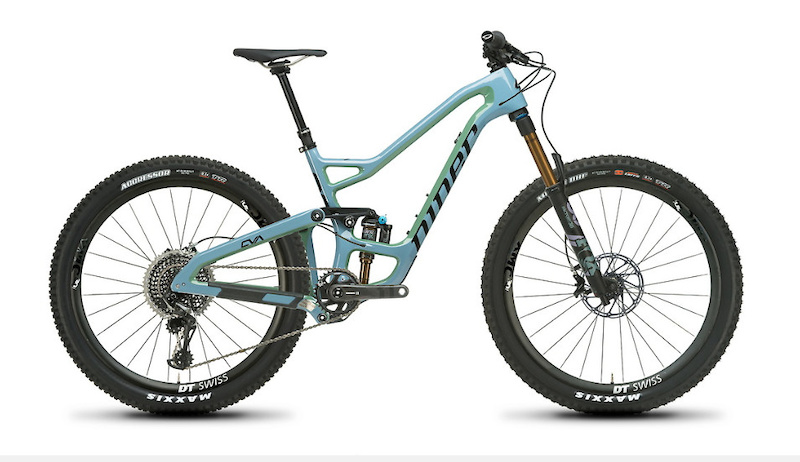


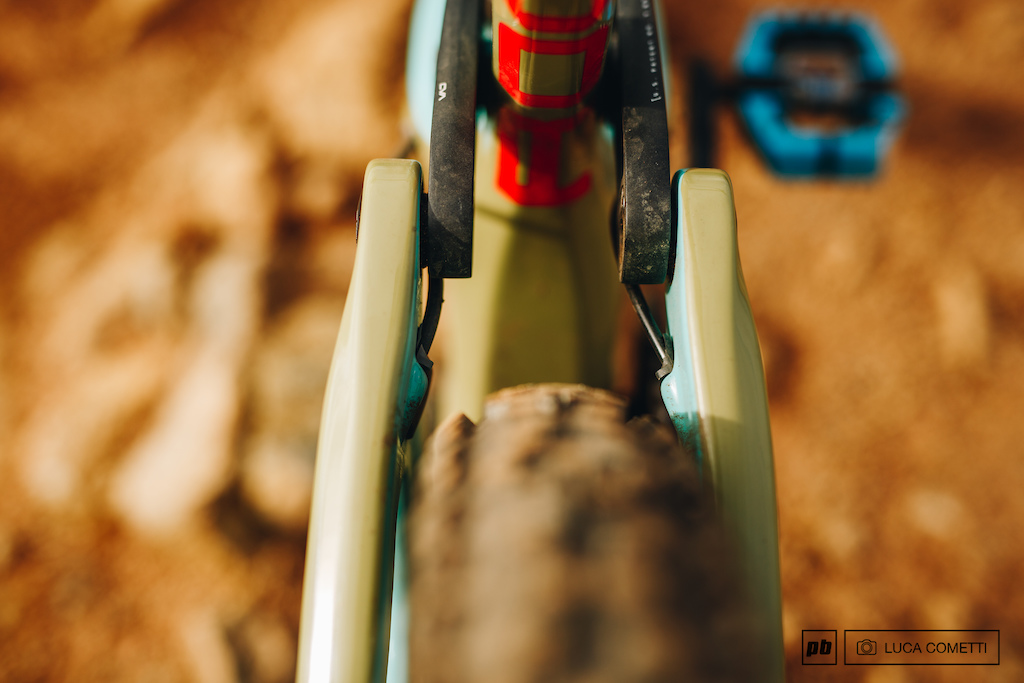
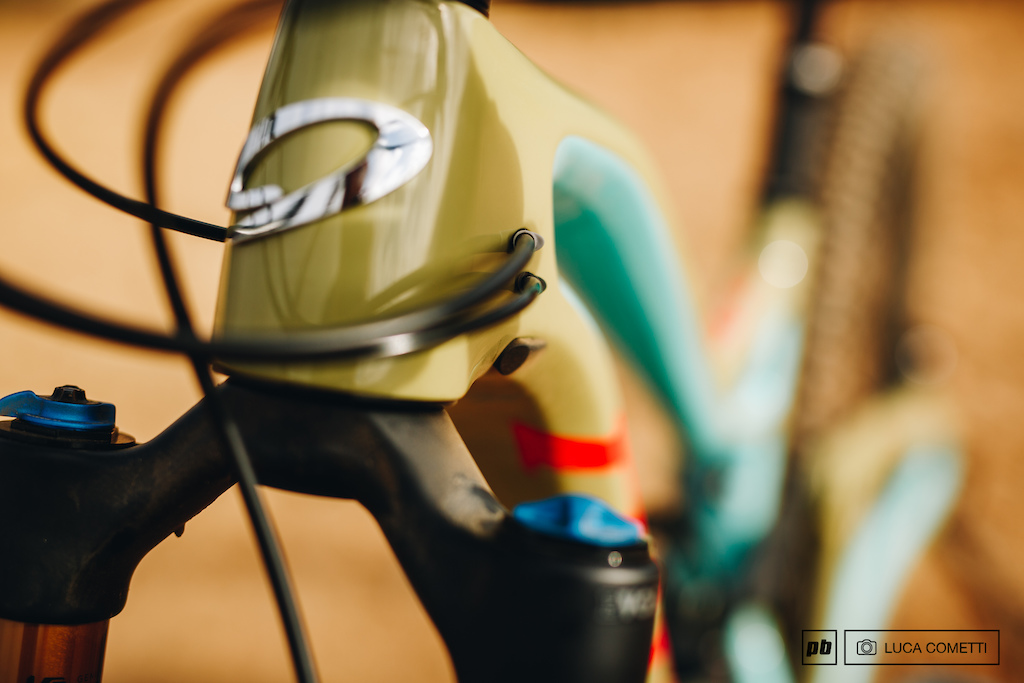
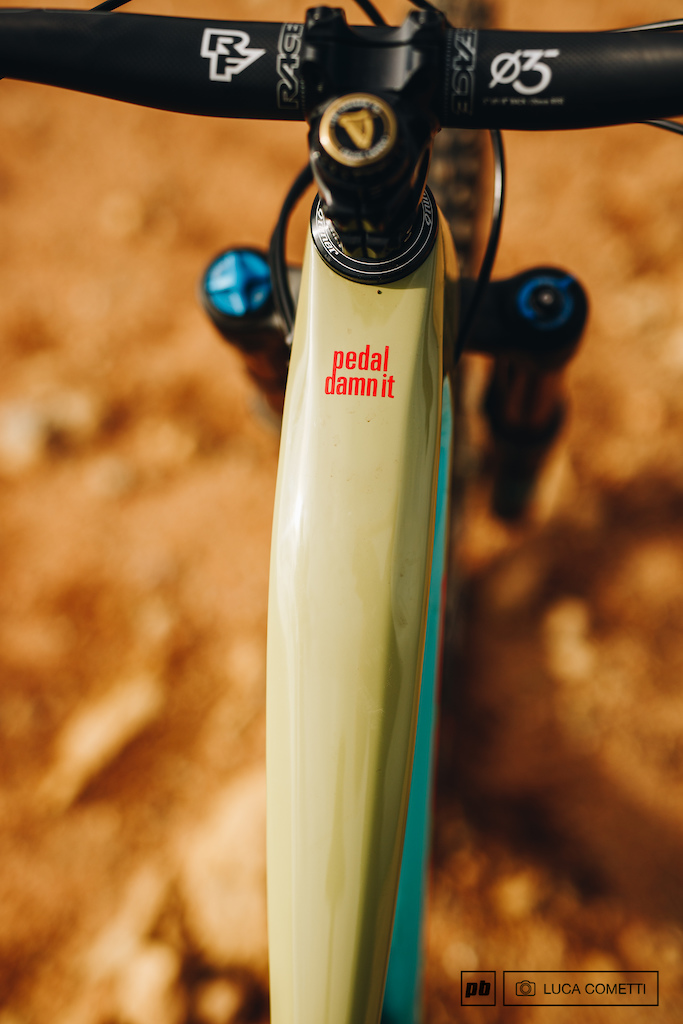
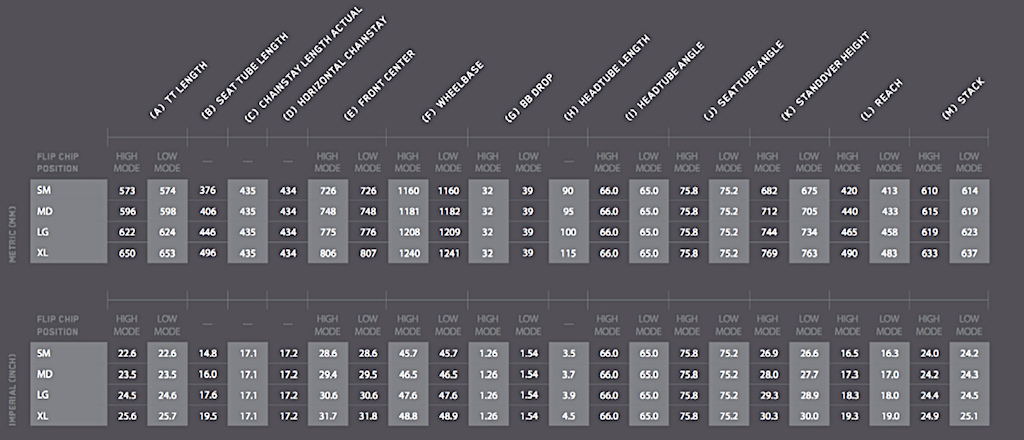
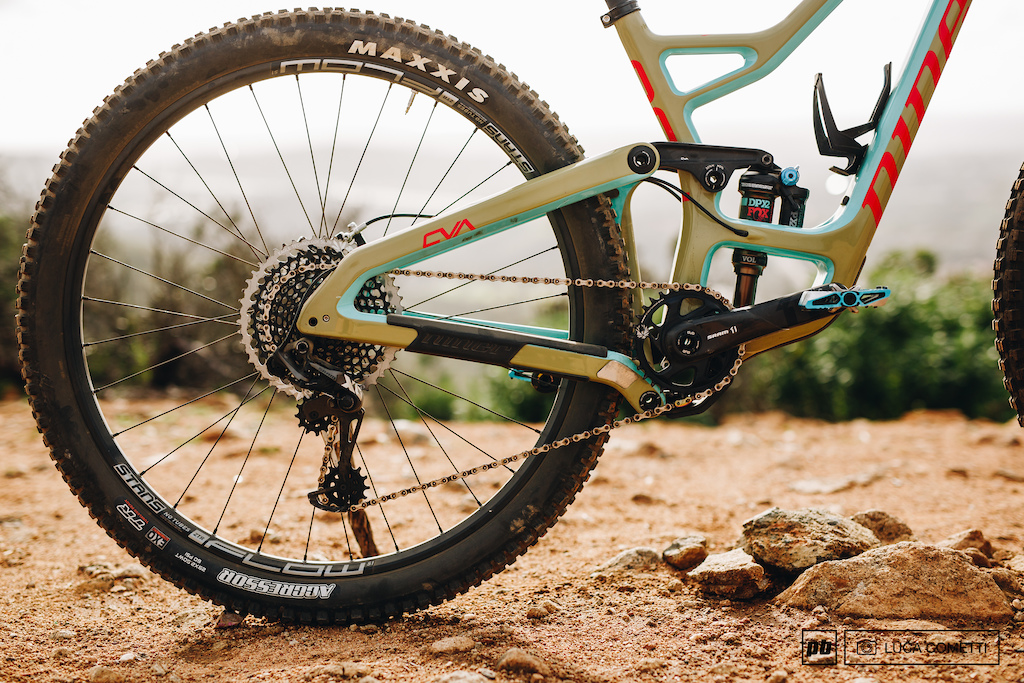


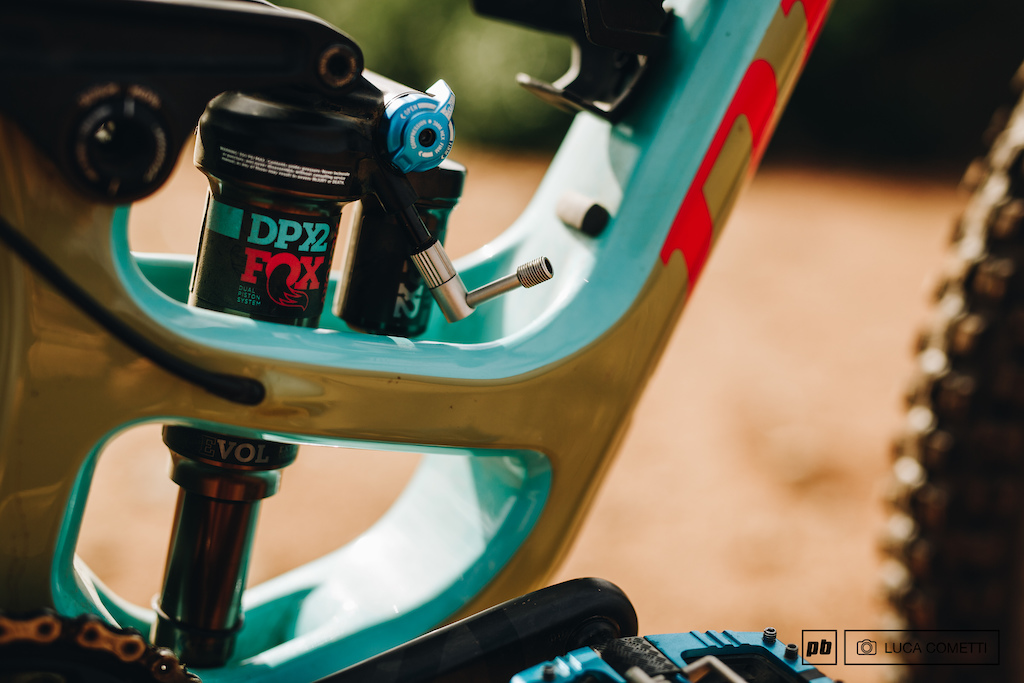





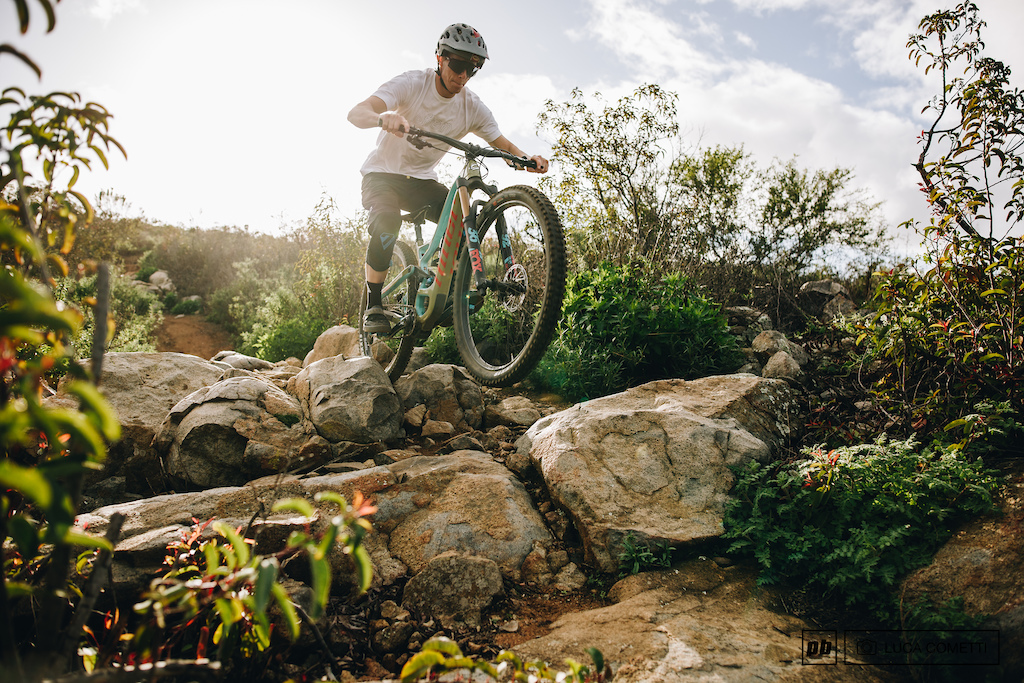
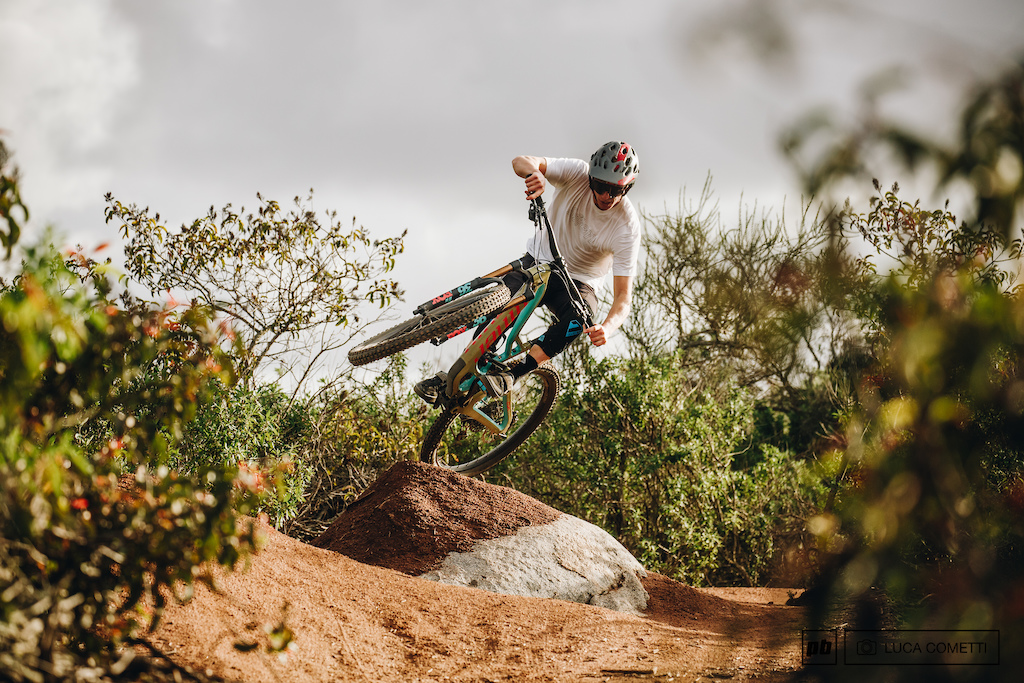

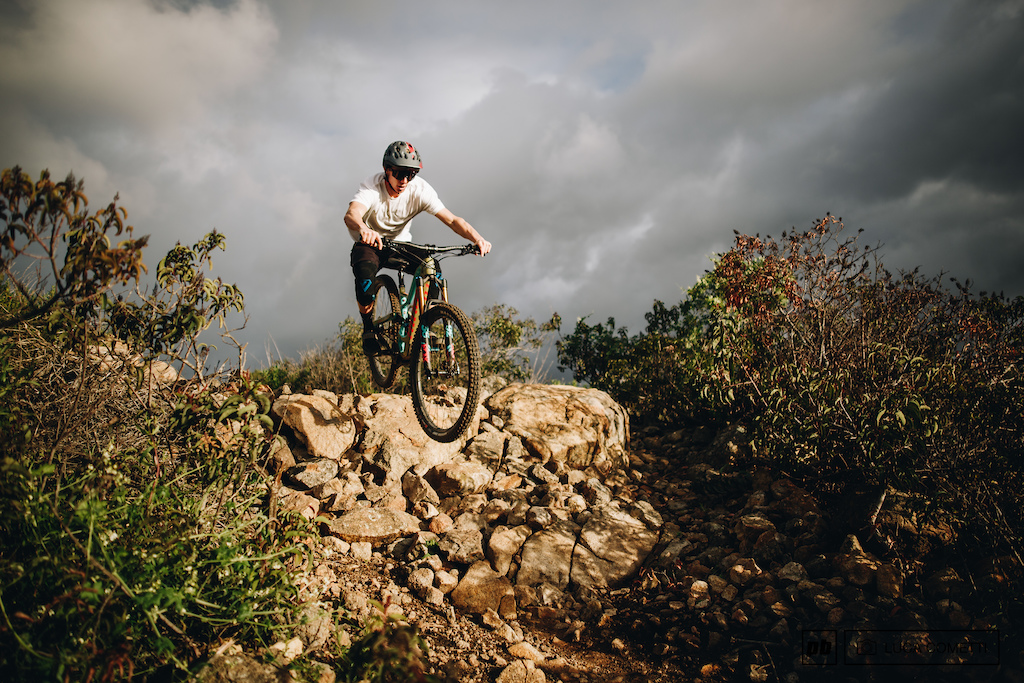
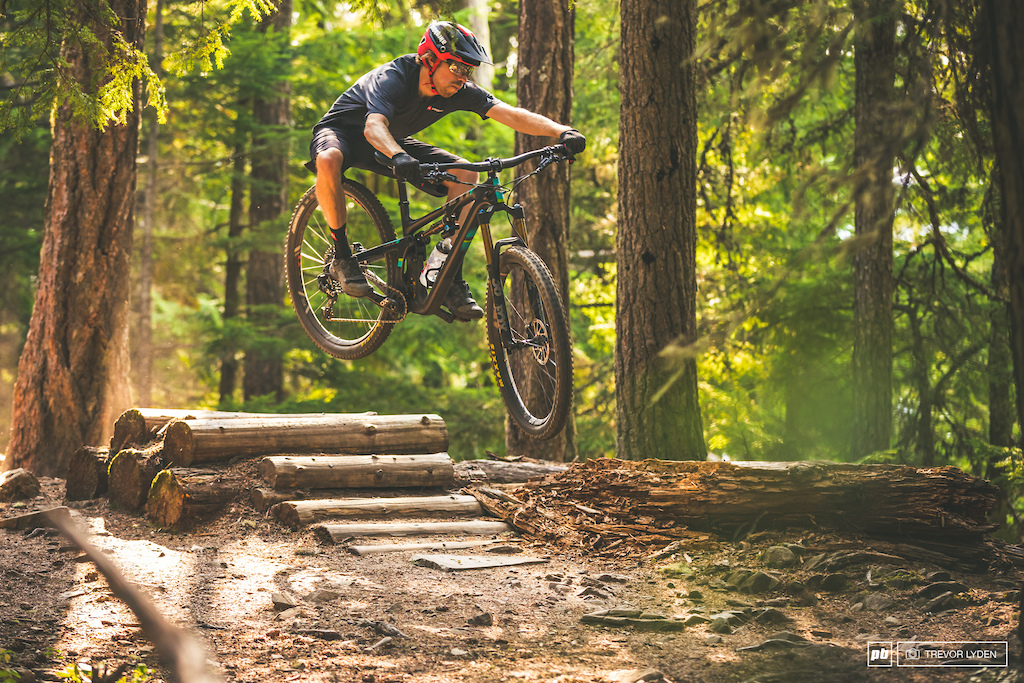
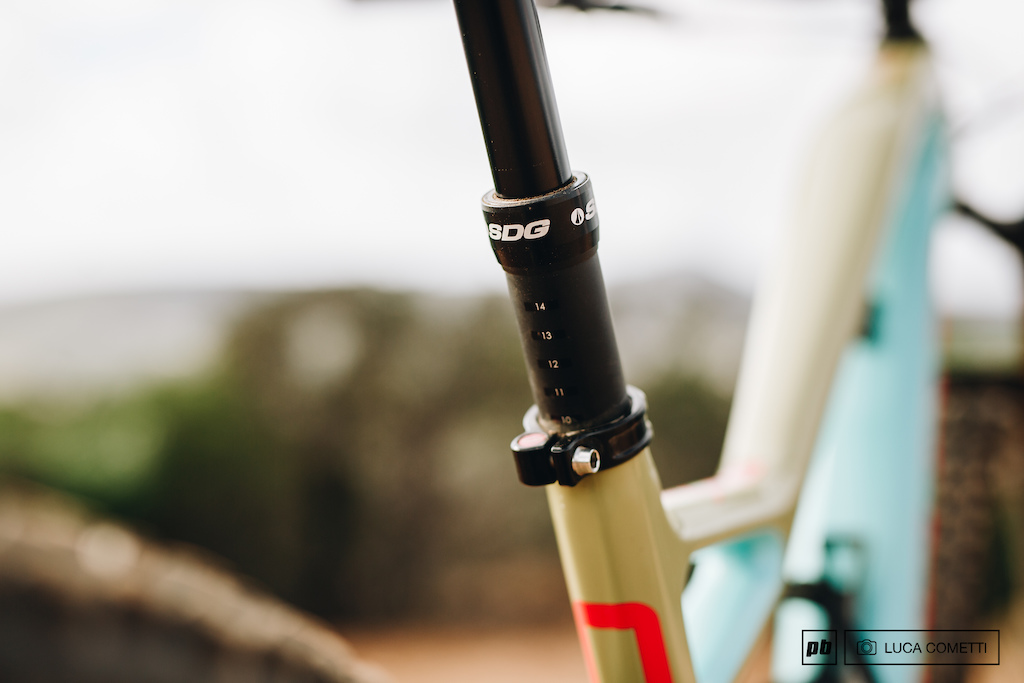
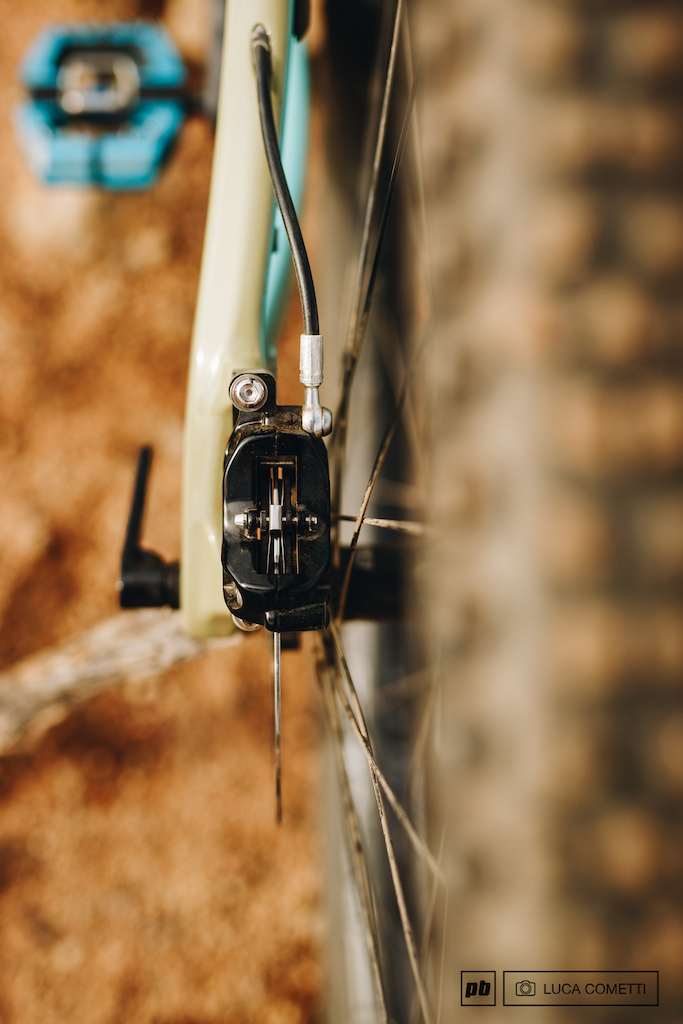



Did they give you any info on the inspiration behind the colour schemes. I thought they either used
1: Paint scheme is only test pot pre production model .
2: Started first coat years ago. Then added 2nd colour after change of ownership
3: used left over yeti and santa cruz paint .
4: non of the above ( Stop being a dick)
Thanks GC
It crams the 29'ers down our throats or it gets the hose again! hahaha
Wtf does that means? So if I ask for it it's gonna be ok then.
Nice review RC. Looks like a cool bike.
It means Guides have similar power to last generation Shimano Deores.
NX Carbon Sentinel - $4,000
NX Carbon Ripmo - $4,200
NX Carbon Rip 9 RDO - $4,500
NX Carbon Stumpy - $4,520 (also not a great value)
Also, has Niner changed their dealer network? Will these go on sale at Jenson at the end of every year as per usual? If so, then it pays to wait and traditional brick & mortar shops will be hesitant to help the brand sell these. I left the Jeffsy out of the above on purpose.
I like the updates though, this looks spot on for an aggro trail bike. Just wondering what else Niner was going to bring to the table in terms of HOW to sell these in the current climate..... small shop only? big shop only? D2C?
- Niner color selector person.
In other words the brakes lack power, not have plenty. L2journalism mate.
But at the end of the day, the reality is that staff at Pinkbike does not write reviews for you specifically so the pros and cons may not apply to you specifically. So a comment like this just really means that you believe this is your world and the rest of us are just privileged to live in it. I am disappointed in the Pinkbike community for upvoting such a dumb comment, we are better than that.
It's possible to provide an estimated height for the "ideal" rider of each size. This would be fairly accurate for most people - certainly better than what we have now - but it's a lot of complication to still end up with imperfect numbers. The only universal, accurate solution is to state the actual angle and offset from BB, then we do some trigonometry.
This is why I said there's no easy answer!
This is why the "reach" dimension took over, though even reach is a little misleading, as two bikes with the same reach fit differently in length if they have different stack. Still, it's a step in the right direction.
Perhaps there should be a measurement from the center of the BB on a vertical plane to the center of the saddle clamp.... That distance would change with the saddle height...
You see where it goes right.
I agree though, I'd like more realistic numbers across the board on all bikes. Some companies measure it all sagged, some don't.
It's just such an emotional televisual l rollercoaster... I can't take it anymore
You can actually effectively communicate seat angle with just two variables: actual seat tube/post angle, and the distance that that straight line is offset from the BB, along the horizontal axis.
With these two numbers, as long as you know your usual saddle height, you can easily calculate exactly where your saddle will be.
Well my post stands, if you trying to give numbers based on inseam everything else I mentioned would also need to be given.
We just need two things, actual seat post angle, and horizontal offset of that slope from the BB. @TransitionBikeCompany will you be the first to give these actually useful numbers?
At the end of the day, it's simply another number to factor into the equation in order to figure out if a bike will work for you.
If we assume that an average rider has the seat approximately at the same height as the handlebar, we would need to add ~15mm for the headset, ~10mm spacer, ~30mm from the stem, ~20mm from the handlebar. So that makes +70mm if we round it down a bit. If we raise the saddle height that much, the effective STA measurement would change radically for these slacked out actual angled bikes. Even more for us tall folks. But that would still give a way more realistic number for most riders out there.
Factor in that people ride different sag and some coil, some air.. Then some set their sag with no kit on then put a rucksack on (camelback), as they remove some of that 3L of water and food etc, then their weight changes.
What if you put an offset headset in which impacts your reach.
Then crank arm length, stem length, stem rise, spacer below stem, handlebar width, bar rise, bar sweep, saddle position...
OMG... I think I will just ride from some approximate static figures and setup from there as there are to many variables to get an exact figure.
There is no magic answer, we are all different and ride setups which are different based on personal preference, strengths and skill level.
Let each rider account for those minutiae to whatever degree they're so inclined.
Nevertheless! I'm happy you're passionate about these nuanced numbers and our delicate minds mulling and musing upon them
Clearly you've never pedaled up a steep grade with your butt behind the rear axle because of a slack seat tube angle...
So please tell me how crank length is irrelevant if you are given a STA for a person with a 29'' inseam.
Others are observing you just need 2 or 3 measurements to calculate an Effective STA at any given height -- just for the frame as a baseline -- nice and simple -- applicable to any inseam/setup from there. Then (...and only then) you can extrapolate all the specifics of Your component/gear choice from there... if you really want to?
It appears you're suggesting either: A) each manufacturer put together a 2000-page spreadsheet calculating all possible variations of components, gear, and height of hemorrhoids; or, B) there are just too many variables, we'll never figure it out, why even try to penetrate the unsolvable mysteries of frame geometry.
Clarification on downvote -- was just a signal of disagreement, not trying to 'disappear' your comment, nothing personal dude. Cheers
1. The valve and the shock eyelet would both need precise threading so it always tightened to the right angle, this is pretty dang expensive
2. The valve moves down towards the "ribs" of the frame meaning if it stuck out there may be frame gouging
Okay, I will. This *ACTUAL* seat-tube angle is not steep. For anyone who is tall, or has a long inseam, they're going to experience a slack seat-tube angle while climbing. The actual seat-tube angle appears to be slacker than the head angle...
#seatanglol
To me, it's counting the number of angels on a pinhead. Who cares? Inseam length, saddle setback, shock sag, etc. all are variables that make it irrelevant IMHO.
Of course, I'm a KISS believer -- Keep It Simple, Stupid. Ride on!
What I don't get is why everyone is suddenly sperging out on seat tube angle. This is a phenomenon that has happened only within the last 6-8 months. Look, most of these bikes are pretty solid, and the geometry is designed on each the make the bike work as a whole. Get a bike you like, test ride it, ask yourself if you like it overall then just ride it, get used to it and have fun, just like you used to before everyone was worried about seat tube angle.
Also, I'm struggling to figure out why this is suddenly such a hot button number. No one cared two years ago.
Find what works for you where you ride and buy accordingly.
Unfortunately a lot of people buy based on brand loyalty, or color, or whatever the dude in the shop sells them.
It's wrong because it makes you push the reach out further to maintain a decent sized cockpit, and it completely imbalances the bike between front and rear-center lengths. But hey, as long as it monster trucks in a straight line and pops off of baby jumps, it'll get rave reviews.
I've heard other guys talk about the long reach bikes of today being nice for regular Joe's as it forces you into attack a bit more, but for racers who really need to move around... that they may benefit from a shorter reach, thus allowing them to throw their bodies a bit more. I can't relate but it'll be interesting.
News flash, you don't need a 4' long front end on a bike to go fast downhill. You need a long *balanced* wheelbase where the front wheel isn't pushing out all the time. When people talk about short chainstays being "playful" and "poppy" on their trail bikes what they're really saying is "hey look I can screw around on this bike at 7mph and it's still fun."
This makes 2 brands who aren't being dumb with geo: Niner and Nukeproof. Even Yeti jumped on the bandwagon with their recent bikes. It's fine to compare this bike to the SB 130 and suggest it won't bomb straight down as well, but I guarantee it will corner better.
[EDIT] Before some jabroni claps back, no, I wasn't suggesting they don't crash because their bikes are long in the back. I'm suggesting they know more about riding fast than the average fast guy, and there's a reason they all want (and finally got) balanced bikes.
What I'm bringing up involves pretty simple math and really boils down to neutral athletic positioning rather than bike features. I can absolutely promise you that a bike with lower FC:RC relationship will rail turns better than one with a high ratio, and that the difference becomes more extreme as a rider fatigues. Yeti makes incredible bikes but they're not magic, and with the SB130 & 150, they've abandoned one of the things that made them so unique: long rear-center values, relative to the front-center.
The SB130 is a hell of a bike, and I'd love to own one. But I would put lots of money down that an average rider would corner drastically better through a fast, loose, un-bermed turn on an SB5.5. Traction would be easier to find, manage and maintain because he/she could apply front wheel pressure in a more neutral position, supported more by their legs instead of their core, shoulders, arms and hands.
I’m really looking to brands like Guerrilla Gravity to take the whole “geo nerd” approach to the next level and offer long stay kits for their new bikes. Until then, if you want a balanced trail bike, you’re looking at Nukeproof, Norco, Niner, or an older design without the long aggressive front-center or raked out HA (and you’ll have a less descending-capable bike due to that).
Forget the numbers and perform back to back rides if you want to prove your theories atleast to yourself. The traction on the new yetis are one of the attributes most raved about aspects of the new bikes. That's just for starters.. Climbing is an entirely other mind blowing aspect along with straight up composure/stability on the downs.. The balance feels perfect despite the numbers.
No, it isn't magic.... But it's made me a better rider in every coming off the last gen versions and that's all that matters to me..
That you feel fast on your new bike in corners is not "real world" evidence of anything. There are lots of reasons why a new bike feels (and is) amazing. I have two Transitions and I love those bikes. But they're probably the worst offenders when it comes to the imbalance I'm talking about. The demand for longer stays has been coming from faster riders than you for years-- you're skeptical right now because you just weren't aware of it.
teamrobotkillsyourface.com/2017/12/19/breaking-news-425mm-chainstays-still-suck
"I’ll extend an olive branch here, and concede that 425mm chainstays can be fun in certain circumstances, like if you’re building a dirt jump bike, or you’re 5’4″, or you suck at riding, or some combination of the three. But if you’re riding somewhere above walking pace, and are at or above global average height, and we’re talking about a full suspension for trail riding, 425 chainstays suck."
www.pinkbike.com/news/behind-the-bike-developing-the-xxl-santa-cruz-v10-2016.html
"As a result of feedback from the back half of 2014 we tooled up an XXL size but made the chain stay longer to maintain the same front/back weight distribution as the XL. Midway through 2015 we continued this progression of thought and made custom lower links to make the chainstays longer still for certain tracks that were loose where front wheel traction was going to be an issue."
Here's a dose of "real" for you.
Hill
Minnaar
Gwin
Rude
Maes
Graves
What's the commonality here? Well, they win more and crash less than their super-elite competition. And they do it while rarely getting out of control. They have all either raced on or requested balanced front-to-rear bikes (either with long stays or shorter front ends), and in some cases forced their sponsor to make special linkages or just redesign their bikes entirely. I'm not saying that is *why* they win. I'm pointing out the correlation between superior, clean riding and the preference for balanced bike geometry.
Something is off when 99% of production bikes aren't doing what 90% of the top of the podium is asking for. I'd have no problem if we sold bikes for "poppy" riding and bikes for stability while hauling ass. I don't think the industry is serving the latter need very well, because they refuse to release a product that won't get the "playful" word mentioned in its reviews.
Ur right.. I can't prove I'm faster in corners on my 130 but all my times are blown out of the water vs my 5.5 and my older 2013 stumpy... I'll chalk that up as a win.. I'll even toss u a bone and say that if perhaps, and this is a stretch, that I'm in fact slower on berms on the new bike,then is by an unnoticeable margin and I have destroyed my times in every other aspect.. But I doubt that..
Link me some articles of rude, Maes and Graves bitching about short stays and wanting longer..
There's nothing special about Rudes Yeti either.. Lots of talk on his Insta about it.. Yet he still smashes..
I stand by my points. I don't just crave playful and poppy.. I crave a well balanced package that comes with mes as close to do it all as possible and the sb130 delivers that on all fronts.
Oh look, I didn't list any downhillers.
Dude, skepticism is fine, but not if you refuse to even try to educate yourself. Then you're just being an ostrich.
And you can't stand by any "points" because you haven't really made any beyond praising your own recent purchase. I'm not saying your bike sucks. I'm saying your bike isn't balanced. Doesn't mean it's not fun to ride. Doesn't mean Ritchie isn't going to tell you it's cool on Instagram. Don't take it personally.
I would personally choose a big travel 29er over a 27 any day for racing enduro, and those guys are racing EWS courses which are honestly closer to domestic DH. So yeah, I'm not surprised he's riding a 150. I would too. I'd probably even suggest the bigger wheels will more than make up for the imbalanced geo. We live in an imperfect world where heroes like Ritchie have to choose the fastest bike Yeti decides they can sell. None of that negates the trend I'm pointing out here.
thanks in advance
If you look at the bikes I'm calling out as more balanced, they generally sit between 1.68 and 1.73. Compare that to the trendy bikes that I'm saying are unbalanced -- my Transition Sentinel and Scout are perfect examples-- which sit around 1.80. And compare those to the really "progressive" (whatever that means) bikes like Pole, Geometron, etc., which are up around 1.9.
One problem is nobody has really explored this at a production level. Another problem is it's very difficult to find a true FC:RC value for a given bike, since the rear axle path varies between designs and the front axle path varies by HA (I have been ballparking the numbers with static measurements, since trail bikes aren't as wild with their linkage designs as DH bikes). Another confounding factor is seat tube angles. We have them all ratcheted up in the air to improve climbing, but with long chainstays that wouldn't really be as necessary (my hypothesis) and so it's not just a matter of bolting longer stays onto a progressive bike (steep STA, long reach, slack HA).
Everything you need to know has been covered by Steve in these videos: www.youtube.com/watch?v=i5R60JHJbxI&t=1s
I'm not skeptic I'm educating myself on my own times and comparisons on many bikes I've owned.. I think companies have a pretty good idea of what makes a bike ride and perform better than someone such as yourself participating in the armchair engineer olympics..
I get it you don't like short stays.. So don't buy a bike with them.. At the end of the day wether u like it or not.. The newer bikes are better.. Yes, that even includes your beloved sb66.. Your hanging on to the past dude..
The big boys will still win on the newer bikes wether u claim unbalanced or not.. I get your points if u are strictly talking a downhill bias.. But not all pros want longer stays..
Still waiting on ur links as to Rude or Graves praising longer stays or requesting it and downplaying the shorter so called unbalanced rears..
Please read what I just wrote about Rude's choice to ride a bigger 29er. And please consider his choice to ride a medium 6.
Please consider using the internet to actually look up geometry numbers before spouting off. Graves 29er Stumpjumpers are lower in FC:RC ratio than any major bike on the market, period. Especially the ST version. The 27.5 Stumpy has numbers closer to HIll's Nukeproof. Graves picked this bike over an Enduro. I'm saying he wants a balanced bike, because he's choosing to ride a balanced bike. Do. You. Understand.?
Richie chose the big wheels because he likes the roll over.. Hes never stated anything about balance.. Hes on a medium because he's he sized down for preference.. Hes in between.. Hes not even on the 6 anymore he's on a 150 98% of the time..
That's great u race bikes.. I dabble myself but who cares really.. Its all internet squabble.. You sound like u have the need to want to squabble to help the ego a bit..
Graves has stated nothing in regards to balance on riding the stumpy.. He chose the stumpy because it performs almost as well as the enduro but in a lighter package.. Believe there is a youtube vid of it as well.. When they were testing them..
I see zero proof still as to your reasoning as to your points as to why they ride what they do.. Nothing dim about it..
At the end of the day it's all about preference anyways.. That or bike feel.
Enjoy the longer stays.
FC:RC
SB6: 1.67
Spesh Enduro: 1.93
...
(Spesh Stumpjumper 29: 1.74)
Yes, it's all about "bike feel," that's real world data. Not like those pesky abstract "numbers."
Nuke proof mega medium ratio is 1.72, the large 1.81, due of course to static chainstay length !!
jilf! the big S grew the stays on the stumpy EVO, which i thought was kinda cool. I may buy one this year.
also, have you ridden a 130? i demoed 8 bikes last year and if i had to choose one today it would be the 130, but the EVO and carbon Sentinel NX are more in my price range this year. i know you opine based on experience, and principles are principles, but 435 stays on an aggressive slacked out trailbike won't make the world implode. the sentinel's fast as hell with those short stays. Also rider preference trumps everything as does the almighty demo. Something that looks right/wrong on paper may feel orgasmic on the trail. Also, I could make the new Stumpy work for me with some setup tweaks, but it was nowhere near as fun to ride as the 130 or Sentinel.
to each his/her own. my first gen Salsa Horsethief had stays in the 460mm range and although straightline climbing and descending was good, it cornered quite like shite. Not once have I wanted to go back. I do like the idea of size-specific stays though, which a few brands are doing, albeit by only a few mm.
What I'm saying is this: it's harder to find, manage and maintain traction (i.e. biting vs controlled drifting) when you ride a Sentinel (or any Transition besides a Smuggler). There's a lot more body english involved because the bike is imbalanced and requires a lot of forward bias to ride it. Since you're already biased you're forced to find traction when you're not in a neutral position. Multiply this times 10 or 20 turns, add core fatigue (and arm/shoulder fatigue) from all that forward bias, and you have a bike that just isn't as good as a neutral one. Sorry, it just isn't. I'm not saying it's slow. I'm not saying it's boring. I'm saying it's NOT AS GOOD as it could be, and that's all to protect the "poppy/playful" short chainstay consumer, who theoretically revolts if they can't ride a manual at 7mph. I think that's dumb, *especially* for a monster truck like the Sentinel.
[EDIT] Big hugs and kisses to the butthurt gangster who keeps down-voting my comments instead of saying something. That'll show me. Pinkbike is so full of idiots.
I appreciate the feedback. And I am curious about the longer stays on the evo, that bike looks pretty well thought out tho the bb is pretty low.
So quick question - size wise I’m right between a L and XL Sentinel (ridden both) so wonder how a L with a 60mm stem would handle to: a) give me my preferred cockpit feel, b) keep the wheelbase in check, and c) help keep the front weighted. Just thinking....
Sb6 is old news dude! Watch rude win on the 150..After his ban that is! Ha
It will be interesting to see if they update a 27" bike, and if so, whether they keep the long rear-center.
I think the updates to the 27.5 are on the horizon.. We'll see how they pan out.
You're fairly careless about accusing people of being "armchair" just because they're discussing ideas on the internet. That screams "I don't know what they're talking about so my ego wants to take them down a notch."
People who race bikes ride at their limit all the time, and they notice things that people who just ride for stoke never do. If you want to push past your limits, you need to understand your bike. I only came to this hypothesis by racing, crashing, making adjustments, winning, and comparing new geometry to old.
If you don't believe me, there's a much more intelligent discussion on this topic over at Vital. No "armchair" in this thread either. One guy is about to build a custom swingarm for his Sentinel:
www.vitalmtb.com/forums/The-Hub,2/The-Internet-Was-Wrong-Short-Chainstays-Suck,9344?unread
Dude I race and ride for stoke.. Hence the reason I bought the 130..It does both so well.. And no, that's no that's not because of new bike stoke or whatever it was u said earlier on.. Its after numerous demoing back to back with other brands and varied geo.
Understand my bike? Ha, ok.. I'm as picky as they come in that regard.
I demo then demo and demo again even just to get down to the final few before making my conclusions. You see that's what actually works vs studying graphs charts and geo numbers.. I say armchair because, well, really, that's what it is. Linking articles on forums for people to read and discuss and banter about.. If that's ur shtick, then great! But keep in mind your linked articles are just bias opinions within themselves..
I'm not saying there's no place for longer stays.. But if I'm crushing all my numbers on the 130.. Well, that's telling me something.. That's all I need.. No article is going to sway real world truths.
Ride all the bikes you can man.. Its the only way really
Great if your gwin or Minaar or aspiring to be.. But I, and I'm sure most will agree, need as close to possible as full package.. With all the traits in one bike performing 95% of the tasks extremely well.. Hence why I chose what I chose..
Also your article is three years old.. Bike companies still haven't changed their thought process.. I guess they all must be doing it Wrong and the engineers and testers have zero clue as to what performs best for the intended bike.
I don't know, just a hunch.
You keep citing your bike and your PRs as if that discounts what I’m telling you, but it doesn’t. It just means your new bike is better than your old bike. If you think the industry wouldn’t sell you something inferior so long as it saves them money and nobody complains... you must be new to cycling. That’s been true for every style of bike ever invented.
Finally, “downhill bias” isn’t some sort of niche focus. I don’t think enthusiast riders are less interested in speed than competitive riders, they’re just less committed to understanding how to unlock it.
Some did corner very well and were very stable at speed, but also lacked in many other areas making them less well rounded..
No downhill bias is not niche, obviously! Your references are mainly Gwin Minaar.. Whom are downhillers. We've already established that if u want to unlock the absolute pinnacle of cornering speed then yes, your links have merit.. But the rider will lose out in other areas.. Those bikes are out there for those people.. Ie pole, nuke proof, mondraker as well as your everyday downhill bikes..
Again, the vast majority are looking for that bike that does 90% of everything pretty damn well.. Hence the new Yetis, Scott Ransom and the soon to be unvailed new Santa Cruz line up (again with shorter cs and steeper SA).
This is not a mistake.. This is companies trying to edge closer to the best or as close to possible in the realm of bikes that have most attributes and do them really farking well!
Finally in regards to industry selling us something with no complaints.. Why the Fuk aren't the pros complaining.. Rude praises his 150 all day long.. Hes genuinely stoked on the bikes via his Insta account... Same with Vinny T and his Ransom amongst many others.. Surely the best of the best would be complaining.. But their not! Same goes for Kurtis Keene..
But your right! The bike industry is making a huge mistake.. We'll all be back to 470mm stays before long.
- DH is irrelevant, but EWS is relevant. It must be that last 20mm of travel.
- A single EWS rider sponsored by your pet brand says his new bike is nice, which should be taken as evidence that his bike is perfect and what I'm saying is wrong. Because of what this kid says about his sponsor's product, we can ignore the older, more experienced guy who regularly beats him (along with everyone else) while riding a bike with the geometry I'm proposing (which he directly developed).
- Even though bikes have drastically changed and improved during the last few years, (as you know first hand with your new Yeti), you're sure the industry has nailed the rear-center, and that dimension will never change because "they must know what they're doing." They just didn't know what they were doing with all those other parts of the bike, despite what their marketing guys told us back when they were selling inferior products.
Oh-kay dude.
You should apply to some major brands and try to land a gig.. Show them all how wrong they've been this entire time and help fix these travesties of bikes we are all riding today.. I don't know how all these pros are riding these unbalanced rigs.
Such a shitty time to be a mountain biker eh with all these geo mistakes..
Haha ok dude.
www.bikemag.com/gear/mountain-bikes/review-yeti-sb130-xo1-race-turq
"The bike corners exceptionally well, but it requires the rider to completely shift his or her weight forward over the front end. It can actually feel unnatural and uncomfortable at first, as you timidly inch farther and farther forward, corner after corner, to get the front wheel to stick. That much forward bias would pitch you over the bars on a lot of other bikes, so it takes some practice to get used to it. Also, it takes more energy, so when you get tired and want to sit up and relax, the bike will understeer and blow corners. But when you're switched on, the SB130 will not disappoint."
"Are you qualified to ride an SB130? That depends, how many push-ups can you do?"
As this is still going I think PB should just cave in and make this a live debate. It'd be fun.
Like I said previously.. If I'm smashing all PR's, that's good enough for me.
Man, you are really hung up on all this aren't Ya? Go ride ur damn bike!
Uh what, no. Anti-squat is suspension’s mechanical resistance to compression due to pedaling forces... You can't have more anti-squat but less "pedal effect" on the suspension unless you define your made up term "pedal effect" to be something other than the effect of the force on the pedals on the suspension.
They should stick to widely used, defined, and accepted terms when describing the suspension characteristics. This is smoke and mirrors marketing speak.
Link to Poles article: polebicycles.com/what-is-anti-squat-and-pedal-kickback
Link to my favorite article explaining suspension characteristics which also supports what I am saying: www.bikeradar.com/us/mtb/gear/article/ultimate-guide-to-mountain-bike-rear-suspension-systems-50849
By "Pedal Effect" do you and Parry mean Pedal Kickback??? That would make more sense, but let's stick to using the term Pedal Kickback since that is a more widely used term. I still have issue with the statement above though:
"That translates to slightly more anti-squat, with less "pedal effect." That's Parry's term for using chain tension to stiffen the suspension - a function many erroneously call anti-squat."
It is impossible (without an idler) to increase anti-squat while decreasing pedal kickback, as they are directly proportional.
Yes, when talking about the instantaneous rate of kickback. Total kickback, however, can be thought of as the area under the anti-squat vs. travel curve. When designing rear kinematics, I like to reduce anti-squat as rapidly as possible beyond a point in the travel at which I've found almost no one will be pedaling. ex. If your bike is nearly bottomed out, you will not be turning the pedals.
Also, we can move beyond simply looking at anti-squat and, instead, look at total force. As the suspension moves deeper into its range, the spring provides more support, so a slightly decreasing trend in the anti-squat curve can be balanced against an increasing spring force to produce a constant total force.
People don't pedal perfectly smoothly and there are inertial forces from our legs, so it's hopeless to try to make a perfect system, but we do our best!
Regarding "pedal effect": I wasn't the one who said it and it's not a term I, or other kinematics designers with whom I've spoken, have used. The article describes it in a way that seems to refer to both instantaneous kickback rate and total kickback, so it's incorrect in at least one way.
The anti-squat of this Niner Rip 9 RDO starts high and rapidly decreases at a nearly linear rate. It's one of the most dramatic total changes in anti-squat I've seen. As such, it should pedal firmly with less total kickback than average. The only caveat is that if the rider uses more than typical static sag, weight transfer when climbing will compress the rear suspension into a range of rather low anti-squat.
I suspect this bike will feel best with a little less sag than average and few, or zero, volume reducers.
Bump
Set
Spike
A guy's gotta eat, but have frames really gotten that much better?
Most manufacturers are doing this now. It seems wrong that the same group that comes on a $1000 bike would also appear on a $5000 bike. Even if you are getting something valuable elsewhere, that alone makes you feel like you are being cheated.
Adapter needed to air the shock...FAIL
Sorry but in this day and age anyone can do better with such designs
Niner: “hold my beer...”
Same here. Did a parking lot test on the old Rip RDO and it's gorgeous in person. Niner makes some lovely carbon bikes, i dig the aesthetics and could make the colors work.
Still waiting for that first-ever Pinkbike trail bike test that is honest and doesn't over hype the downhill abilities of a bike with a 65 head angle and 160 mm of travel.
Does a coil fit in here?
I'm no longer interested in 1994. Nor are most of you.
Everyone one make a big deal over Niners lower link, the thing is tough and it moves/tucks up when the suspension compresses.